TechRadar Verdict
A great running and triathlon watch, with slim design, long battery life and now a much better price to go along with it. Although a little lightweight in nature it's more than good enough to function as a daily timepiece, and actually shows up some of the more 'dedicated' smartwatches.
Pros
- +
Long battery life
- +
Good smartwatch functionality
- +
Accurate GPS
Cons
- -
Plastic feel
- -
Some fitness tracking could be better
- -
Heart rate monitoring not great from wrist
Why you can trust TechRadar
The Garmin Forerunner 735XT has now been followed by the Forerunner 745, but is still one of the best triathlon watches around – and an excellent aspirational buy for anyone who enjoys just running and cycling too.
We say aspirational because it's powerful and feature-rich enough on each of the disciplines that it's worth thinking about as just a dedicated model in each of those.
With a sleek design, long battery life and interesting insights into things like running dynamics - and an integrated heart rate monitor – it's definitely got all the features we'd like, so is it the watch you should be looking for?
We're likely to see some good deals an Garmin watches for Prime Day 2021, based on our experience in previous years. The Forerunner 735XT is among the models most likely to receive a discount as Amazon makes room in its warehouses for newer stock. Although a few years old, it's a superb watch, and well worth snapping up at the right price.
Garmin Forerunner 735XT price and release date
Launched in May 2016, the 735XT isn't the newest on the market, but it still stands up to the best the market has to offer right now.
The price is also dropping, so where it launched at around £350, you can now buy it for £300 in many places, with some holiday deals seeing it drop as low as £235, or £245 with the additional heart rate monitor.

Design and screen
- Sleek design
- Clear screen
- Slightly lightweight
One of the strongest, most impressive things about the 735XT is that it's such a sleek device with so many features inside. If you've seen the 910XT or the Forerunner 920XT, you'll know that the previous triathlon watches from Garmin have been chunky things to strap to your wrist.
Sign up for breaking news, reviews, opinion, top tech deals, and more.
Somehow Garmin has managed to put all that tech into a thin, rounded model. It's not the smallest in the world - people will still recognise this as a fitness watch on your wrist - but it's more stylish than many.
It comes in two colors, black and frost blue (we tested the latter, and it garnered a lot of attention with the way the color of the strap integrates with the face of the 735XT) and the rubberised straps are really comfortable, even when put on tightly to facilitate the heart rate monitoring.
Also, unlike many running watches, the straps are easy and wide enough to fasten quickly - try something like the Samsung Gear Sport, with its two 'holding lugs' and you'll know frustration.
The screen is low res compared to some of the smartwatches on the market - it’s not going to rival the Apple Watch 3, for instance - but it’s perfectly legible in all conditions, without needing to switch off to save battery.
It uses a transflective screen which uses the available light to bring the clarity to your runs. Not having to raise your wrist to wake is a massive plus, and the illuminating light is more than legible at night (and you can leave it turned on, although this predictably sucks battery a little more).

Running
- Very accurate and quick GPS
- Lots of useful metrics
- Loads of data readings
We love running with the Garmin Forerunner 735XT for a number of reasons - mostly because it’s an accurate and easy-to-use machine strapped to your wrist.
We used the Forerunner 630, a more dedicated running model, for a number of months, but the fact this used a touchscreen irked. No such issues with the 735XT - this is all button, meaning you can fondle your wrist without looking for the right button on the screen to finish a race or save an activity.
The accuracy is excellent, and as such it’s our go-to watch for a race if we want to benchmark another wearable. We’d even start to disbelieve mile markers in races, such is the general correctness of the GPS.
That GPS is also very quick to click in - curiously, more so than the better-specced Garmin Forerunner 935, which is more expensive. And even with all the GPS / GLONASS tracking on, the battery life doesn’t suffer too much, which is a real plus.
We won’t go into detail about all the things you can do running with the 735XT, but suffice to say there’s not a lot we want for. Virtual pacing, lap/pace/heart rate alerts that you can customise, the ability to drop your training plans into the mix from the web are all real boons… in short you can do everything you need with the watch.
The customisation on the data screens is also excellent, meaning you can know precisely what two clicks up or down is going to do when running, without having to break stride to make sure.
The running dynamics are cool… but we’re not sure most people would get that much benefit. The only really useful one is the ability to monitor whether you’re landing harder on the left or right, and you’ll need to use the additional heart rate strap to get the information.
Another little boost that we like from the watch is the addition of heart rate variability (HRV) tracking. This unlocks the secrets of your body, tells you if you’re tired at the start of the run and can monitor the point when you transition from aerobic (using oxygen to run) to anaerobic (no oxygen, using the fuel in the muscles which can only be done for a limited time) running.
Knowing this, and we found it to be really accurate in our marathon training, can help you over a long race by making sure you don’t cross your lactate threshold and start getting into oxygen deficit. It’s a really nice feature and one Garmin is nailing in its range.
The heart rate monitor underneath, designed to monitor your pulse from your wrist, is less accurate though, with it often taking a while to click in and giving false readings at the start of most runs.
When it works, it works well - it's just a long way from flawless.

Multi-sport
- Excellent for triathlon
- Swimming and cycling also fully-featured
- Easy transition monitoring
You can also go swimming and cycling with the Garmin Forerunner 735XT, and like the running there are a lot of metrics you can track.
When it comes to swimming, we found that it’s an excellent choice for the drill-based swimmer. Not only does it have a dedicated drill mode (that is slightly hard to set up if you’re uninitiated) but you can also set in rests and have them show in the app later - in short, it’s excellent for tracking the details of your swim.
We did find that the accuracy of the length counting stuttered on occasion, and that’s something that’s prevalent throughout the Garmin range. It’s not massive and every single time, but we couldn’t trust the accuracy of the length counter.
It’s highly possible that we’re not pushing off the ends properly, which is what the watch needs to track the transition from one length to another, but it still irked.
The buttons are really easy to hit in the water, and the screen is also highly visible underwater, with the stroke detection also working well in our testing, with the data being very easy to interrogate at the end, as mentioned.
In short, although the accuracy can sometimes err, the swimming capabilities of the Forerunner 735XT in a pool are great for someone putting together drills. Although we didn’t test it in open water, if it’s anything like its predecessor (and one would assume Garmin has improved things) the tracking is great and the stroke detection - combined with the GPS tracking - is pretty accurate.
With cycling, it’s hard to really fault the Forerunner 735XT as it’ll not only offer you all manner of metrics (hopefully, you’re getting the theme here) but also connect to ANT+ and Bluetooth accessories, meaning most power meters and turbo trainers are compatible with the watch and can upload your activities easily.
The only thing that really irks is there’s no strap extender, so it’s not easy to lock this watch into your handlebars as a quick readout of your stats.
Battery

- Mega-long battery life
- Can run at least five times before charge
- Will only lose 30% on a 31 mile run, four hour run
The battery life of the Garmin Forerunner 735XT is, in short, just great. We regularly get five days’ use out of it, even running every day and having it work as a fitness tracker, meaning you’ll build up some quality sleep tracking information.
Even with it connected to a smartphone, the battery life hold on incredibly well - this thing could easily do an ultra marathon.
Actually, we tested just that: over 31.1 miles, from a full charge the Garmin Forerunner 735XT managed to only lose 30% battery, which is pretty incredible. While we’d be worried about doing 100 miles off one charge, you can enable Ultra-trac mode and easily make it through.
It might not be as accurate, but the fact is you can easily go the working week on one charge with the Garmin Forerunner 735XT and not have to worry.

Interface
- Easy to use interface
- Garmin Connect is a powerful app
- Fitness tracking could be better
The interface of the Garmin Forerunner 735XT is pretty easy to use when you get your head around it - and find the myriad secret functions enabled by holding down various keys at different times.
It’s easy to manipulate at pace, which is a dreamy thing to offer - we were able to alter our virtual pacer (the function where you can see how far ahead or behind a certain speed you are) in the middle of a race and it only took a few seconds.
It’s also great how the notifications pop up on this watch - when connected to your phone, you’ll get just the right amount of preview to see whether you need to look at that text or WhatsApp message, or whether it’s worth taking the call.
The Garmin Connect app is a fairly divisive platform - we’re fans of the way the app can just do so much, but it can get a bit overwhelming at times.
That said, recent upgrades are good at giving more insight, telling you when you’re ahead or behind your usual activity, showing your sleep patterns, activity levels and calorie intake (if you sync it with something like MyFitnessPal).
The sleep tracking is a little rudimentary and lacks the insight of some competing platforms, but overall it offers a good look at your motion at night and is a little more sensitive than something like Samsung Health, which we like.
Verdict

The Garmin 735XT is a great watch for all manner of disciplines, but it shines as a triathlon watch. Recent price drops mean in some sales it’s a really compelling running watch as well, which means that you’d be hard-pressed not to pick it up with the enhancing heart rate monitor too.
It’s got a clear screen, good battery life, great accuracy and the ability to give deep insight into a number of facets of your fitness life - and it’s also advanced enough to be the perfect companion in something like a marathong
Should I buy it?
In a word, at some of the recent prices, yes. It’s a great, sleek watch with so many functions, but no issue if you don’t use them all.
It’s got such a robust GPS system that we’d almost question the way some races are laid out, as you’ll hear a number of other Garmin watches going ‘ping’ at the same time a few metres before a mile marker.
The fact you can set so many different ways to run, cycle or swim on this thing - combined with an attractive design - mean it’s one of the best fitness watches on the market right now, along with being a strong fitness tracker and sleek enough to wear every day.
- Find the best deals on Garmin products with our Garmin promo codes.

Gareth has been part of the consumer technology world in a career spanning three decades. He started life as a staff writer on the fledgling TechRadar, and has grew with the site (primarily as phones, tablets and wearables editor) until becoming Global Editor in Chief in 2018. Gareth has written over 4,000 articles for TechRadar, has contributed expert insight to a number of other publications, chaired panels on zeitgeist technologies, presented at the Gadget Show Live as well as representing the brand on TV and radio for multiple channels including Sky, BBC, ITV and Al-Jazeera. Passionate about fitness, he can bore anyone rigid about stress management, sleep tracking, heart rate variance as well as bemoaning something about the latest iPhone, Galaxy or OLED TV.
